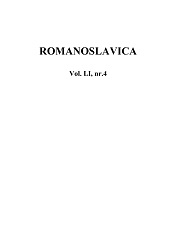Уметничке и покретне слике активни чувари културног наслеђа Cрба у Румунији
Artistic and moving paintings as active guardians of the cultural heritage of Serbs in Romania
Author(s): Petrija JovičićSubject(s): Museology & Heritage Studies, Visual Arts, Cultural Anthropology / Ethnology, Film / Cinema / Cinematography, Sociology of Art
Published by: Editura Universităţii din Bucureşti
Keywords: cultural heritage; Serbian-Romanian cooperation; Serbian art; ethnographic film;
Summary/Abstract: The aim of this study is to present concisely the reflection of the cultural and artistic influence by means of fine arts and film creations which as a medium and through their activism establish an elaborate net and bridge of Serb-Romanian cooperation thus making an infinite contribution to filigree modeling and protection of centuries-long cultural and spiritual heritage of Serbs in Romania. The approach to the subject with regards to its cultural and artistic connotation provides a long list of all those who contributed to the preservation of the cultural heritage of Serbian people in Romania. Through their work that enable visual presentation of life characters, using this distinctive practice they concisely point out to the cultural meanings and thus become faithful “guardians” of material and spiritual cultural treasure eager to reveal their art on all social levels. The fact is that works of art and visual experience remain deeply imprinted in the minds of art consumers, and the images of past are passed down from generation to generation, all of which contribute to the preservation of the cultural heritage. Throughout this study I divided and explained the subject matters on three different levels: 1) Artists/painters – presentation of art, Romania – Serbia; 2) Film production – realization and presentation of documentary – ethnographic films; 3) Diversity, directions and guidelines of presenting artistic accomplishments as “guardians” of tradition of Serbs in Romania. There are many reasons for dealing with this subject, since artists through their works and instruments of visualization show everyday life and customs, shaping it every day, and thus stepping beyond the boundaries of aestheticism and becoming the carriers of solid cultural connotations. Over the past twenty years in Serbia and Romania, visible interests of exhibitions have been revealed through different events. Films that show structural discourse of everyday life and tradition give the ethnographic film the concept of cultural meaning. Magical power of the ethnographic film – the youngest branch among the centuries-old traditional forms of artistic expression- includes the images of culture-now and then. These images by using documented history and subjective memories, construct the history, the imperfect remembrance and identity performances. They actualize the active experience of images of past times into the horizon of present creating the narrative frame which gives us the permission to, through foundation of visual anthropology, say that we are the bearers and promoters of cultural heritage. The idea of this study is to offer a suggestion that, through the creation of virtual gallery, virtual material of artistic provenance can become the link between the center and the scattering.
Journal: Romanoslavica
- Issue Year: LI/2015
- Issue No: 4
- Page Range: 269-282
- Page Count: 14
- Language: Serbian

